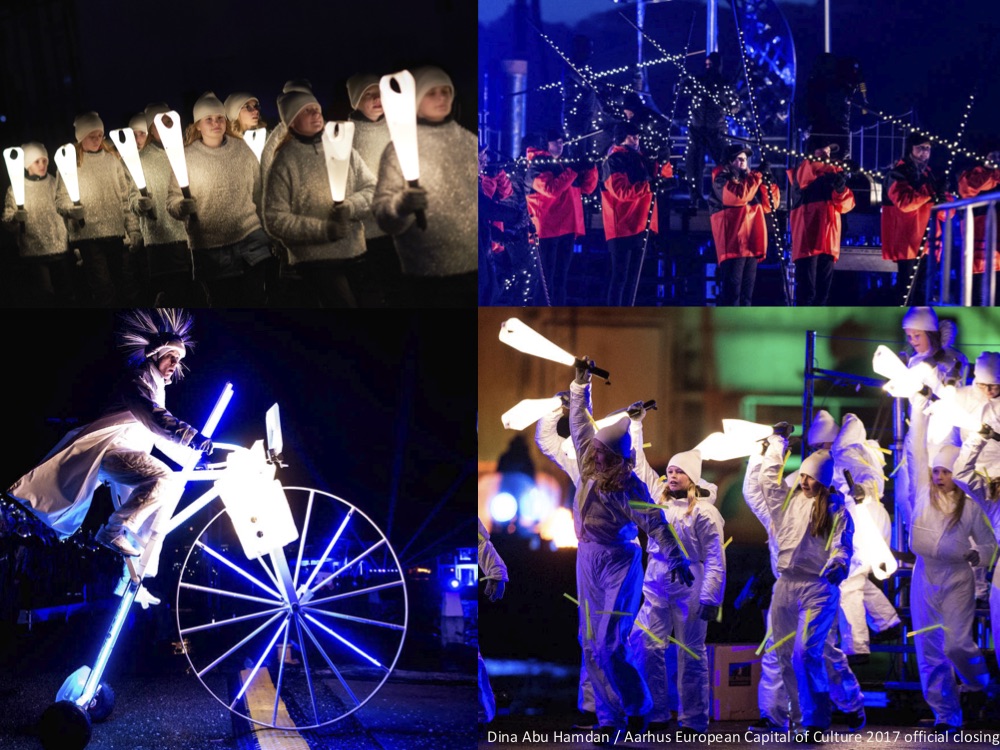Intercult invited four socially engaged and changemaking women artists and practitioners to present the frame of their community building methodology.
Dina Abu Hamdan is an interdisciplinary artist, artistic director, producer.
She believes that the important thing is to give voice to the people, give them joy and empowerment. This will create a new thinking of their place.
Here is the process of her work with the community and children in making spectacles.
Collective memories and stories of towns and communities reconstructed for outdoor theatre spectacles
Gathering collective memories and stories of towns and communities, in order to regenerate narratives and dramaturgies to present on medium large outdoor spectacles, is a work that entails massive networking and organization. The work extends with almost every community group, or club, or a talent in addition to grassroots research, open negotiation, layered narratives, and a clear artistic vision that even the youngest performer in the spectacle is able to imagine and fantasize about. The result is an equally shared collective social responsibility.
How can I, as artistic theatre director, a foreigner to a town, give the town and its local community, a spectacle that tells its stories, sparks the imagination, and brings people together in a celebration of which they are proud? This is often the question I ask myself every time an organizer asks me to put on a new spectacle in a new town!
There is no secret methodology; my starting point is the place, the people who live there and their collective stories and history. My work often has non-linear narratives mirroring my research method. I tend to take the main collective stories, and explore them further and further through informal meetings, town walks and talks with different community members and age groups. Inviting them to share their personal stories or memories around the same major incidents or major events lived their town.
With children I often do workshops, dance and play activities, in order to dialogue and sneak into their imagination.
In many cases images, stories, photos, and sounds are generously shared with me, which change the course of my research, the priority of our meetings and investigations. So grows this web netting of images.
In this process I look for untold, and unwritten experiences, sounds, colors, feelings. I look for individual, intimate stories and situations that I often restage as sub narratives. As I spin around community meetings, I carry and revive these stories and some of the shared pictures or elements I have been given, unlocking the community memories and building up a dramaturgical line that I myself could never have imagined.
What makes it very interesting for me is to stage this unimagined narrative that is woven by the community itself, yet artistically.
My artistic approach tends to deconstruct the intimidating collage of lining up the different community groups so that they don’t get to perform only what they usually do. The mission is to reconstruct new images where the community groups equally with professional artists are given new and most often strange tasks in order to create layered images, which will collectively retell the collective stories. Trusting the traditions and talents of the participants, and their practices, also pushing the limits of the imagination to regenerate the possessed technique in new forms. Everyone in this process is a pro star. This entails a second phase of training and workshops with the local community members. These workshops may end up being held in the backyard of a factory, if I am working with factory workers, or in the canteen of a mobile company during the employees’ breaks, or at the harbor as early morning as 5am if I am working with fishermen. Together round the clock, I hop along my team from one location to another, training, dreaming away and sculpting a fraction of the coin!
Parallel to the community work on the ground, another layer of the work is massively around inspiring the professional artistic, music and scenography teams. Consequently, forming the first major bridge between the local and the professional; a solid collaborative production team that is highly flexible to adapt to building the collective musical score, and the scenography narrative elements is key for putting up such large- scale spectacles involving community members.
The outcome is a true meeting, a thin line between the professional performer, maker and the community member /amateur is devised. Equality on stage along with community empowerment by giving access to high caliber artistic direction and production elements is an act of inclusion, participation, ownership and a lifetime transformative experience towards the arts, both for participants and audience. Finally, it is a new warm memory of rediscovering and reshaping the usual experiences in our towns for generations to come.

